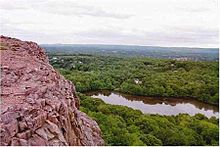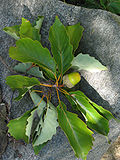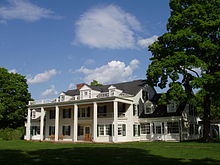- Metacomet Trail
-
- This topic is about a footpath in Connecticut. It should not be confused with the similarly named Metacomet-Monadnock Trail of Massachusetts and New Hampshire.
Metacomet Trail 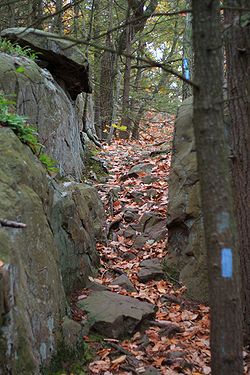
Blue-blazes mark the Metacomet Trail Length 51 mi (82 km) Location Hartford County / New Haven County, Connecticut, USA Designation Psrt of a National Scenic Trail Use hiking, snowshoeing, other Highest point West Peak
1,024 ft (312 m)Lowest point Farmington River
150 ft (46 m)Trail difficulty easy, with difficult sections Season easiest spring to fall Hazards deer ticks, poison ivy, copperheads (in places) The Metacomet Trail is a 62.7-mile (100.9 km) Blue-Blazed hiking trail that traverses the Metacomet Ridge of central Connecticut and is a part of the newly designated 'New England National Scenic Trail'. Despite being easily accessible and close to large population centers, the trail is considered remarkably rugged and scenic. The route includes many areas of unique ecologic, historic, and geologic interest. Notable features include waterfalls, dramatic cliff faces, woodlands, swamps, lakes, river flood plain, farmland, significant historic sites, and the summits of Talcott Mountain and the Hanging Hills.[1][2] The Metacomet Trail is maintained largely through the efforts of the Connecticut Forest and Park Association.
On March 30, 2009 President Barack Obama signed the 'Omnibus Public Land Management Act of 2009' establishing the New England National Scenic Trail (and two other national scenic trails).[3]
The combination of the Metacomet, Monadnock and Mattabesett trails is also often referred to as the '3-M', 'MMM' or Metacomet-Monadnock-Mattabesett trail. The New England National Scenic Trail includes all or almost all of the 'MMM' trails as well as a the new extension trail from the southern-most point on the Mattabesett Trail through Guilford, Connecticut to the northern shore of Long Island Sound.[4]
Contents
Trail description
The Metacomet Trail extends from the Connecticut/ Massachusetts border south through Hartford and northern New Haven counties in Connecticut. The southern terminus of the trail is located just east of the Hanging Hills on U.S. Route 5, 4 miles (6 km) north of the city of Meriden, in the town of Berlin, Connecticut; the northern terminus is located in the hamlet of Rising Corner, part of Suffield, Connecticut, 7 miles (11 km) southwest of Springfield, Massachusetts. The 110-mile (180 km) Metacomet-Monadnock Trail in Massachusetts and the Monadnock-Sunapee Greenway in New Hampshire continue the footway north from the Metacomet Trail another 160 miles (260 km) to central New Hampshire. The 50-mile (80 km) Mattabesett Trail picks up where the Metacomet Trail leaves off in Berlin and continues south to Totoket Mountain then northeast to the Connecticut River in Middletown.[1][5][6]
Significant networks of shorter hiking trails intersect the Metacomet Trail, most notably on Talcott Mountain, the Hanging Hills, and Ragged Mountain.[1]
The Metacomet Trail is primarily used for hiking, backpacking, picnicking, and in the winter, snowshoeing. Portions of the trail are suitable for, and are used for, mountain biking and cross-country skiing. Site-specific activities enjoyed along the route include hunting, fishing, horseback riding, boating, bouldering, rock climbing (access), and swimming.[1][7]
Trail route
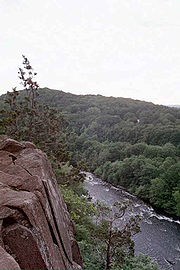 Tariffville Gorge from Hatchet Hill
Tariffville Gorge from Hatchet Hill
The Metacomet Trail traverses the trap rock Metacomet Ridge which extends from Long Island Sound to the Massachusetts/ Vermont border. This ridge, rising hundreds of feet above the Connecticut River, Farmington River, and Quinnipiac River valleys, is a prominent landscape feature of central Connecticut. From south to north, the trail uses the ridges of the Hanging Hills, Short Mountain, Ragged Mountain, Bradley Mountain, Pinnacle Rock, Rattlesnake Mountain, Farmington Mountain, Talcott Mountain, Hatchet Hill, Peak Mountain, and West Suffield Mountain. Abrupt vertical cliffs with visible talus slopes and frequent viewpoints are common throughout. Views are generally to the west from West Suffield Mountain south through Ragged Mountain; with views in all directions at varying points in the Hanging Hills. The Farmington River cuts through the ridgeline between Hatchet Hill and Talcott Mountain in the Tariffville Gorge (east of Simsbury). Historic features along the trail include Old Newgate Prison museum and copper mine in East Granby; Heublein Tower on Talcott Mountain with expansive view of four states; the Hill-Stead museum in Farmington, Connecticut, notable for its French impressionist painting collection and gardens; and Hubbard Park of the Hanging Hills of Meriden, designed with the help of famous landscape architect Frederick Law Olmstead and crowned with a small observation tower known as Castle Craig.[1][7][8] The trap rock ridges and talus slopes of the Metacomet Ridge are also home to several unique microclimate ecosystems that support species of plants that are unusual or endangered in this part of New England, and are a seasonal migration path for raptors.[9] Viewshed from the ledges include agrarian land, suburbs, small towns, river corridors, the eastern Berkshires ridgeline, and metropolitan Meriden and Hartford.[1]
Trail communities
The Metacomet Trail passes through land located within the following incorporated towns, from south to north: Berlin, Meriden, Southington, New Britain, Plainville, Farmington, West Hartford, Avon, Bloomfield, Simsbury, East Granby, and Suffield, Connecticut [1][10]
Landscape, geology, and natural environment
The Metacomet Ridge that forms the spine of the Metacomet Trail was formed 200 million years ago during the late Triassic and early Jurassic periods, and is composed of trap rock, also known as basalt, an extrusive volcanic rock. Basalt is a dark colored rock, but the iron within it weathers to a rusty brown when exposed to the air, lending the ledges a distinct reddish appearance. Basalt frequently breaks into octagonal and pentagonal columns, creating a unique "postpile" appearance. Huge slopes made of fractured basalt scree are visible beneath many of the cliffs along the Metacomet Trail.[11] The Metacomet Ridge was the product of several massive lava flows hundreds of feet deep that welled up in faults created by the rifting apart of North America from Eurasia and Africa. The basalt floods of lava occurred over a period of 20 million years. Erosion occurring between the eruptions deposited deep layers of sediment between the lava flows, which eventually lithified into sedimentary rock.
The resulting "layer cake" of basalt and sedimentary sheets eventually faulted and tilted upward. Subsequent erosion wore away the weaker sedimentary layers a faster rate than the basalt layers, leaving the abruptly tilted edges of the basalt sheets exposed, creating the distinct linear ridge and dramatic cliff faces visible today. The best way to imagine this is to picture a layer cake tilted slightly up with some of the frosting (the sedimentary layer) removed in between. The sedimentary rock of the Metacomet ridge is well known for its fossils, especially dinosaur tracks.[11]
The Metacomet Ridge hosts a combination of microclimates unusual in New England. Dry, hot upper ridges support oak savannas, often dominated by chestnut oak and a variety of understory grasses and ferns. Eastern red cedar, a dry-loving species, clings to the barren edges of cliffs. Backslope plant communities tend to be more similar to the adjacent upland plateaus containing species common to the northern hardwood and oak-hickory forest types. Eastern hemlock crowds narrow ravines, blocking sunlight and creating damp, cooler growing conditions with associated cooler climate plant species. Talus slopes are especially rich in nutrients and support a number of calcium-loving plants uncommon in Massachusetts. Many bogs, ponds, and reservoirs lie cupped between trap rock ridge shelves, demonstrating the value of these ridges as important aquifers and wetland ecosystem habitats. Because the Metacomet Ridge generates such varied terrain, it is the home of several plant and animal species that are state-listed or globally rare.[9][12]
Other ecosystems on the southern sections of the Metacomet Trail include the northern riverine community which supports species such as willow, American elm, and sycamore; this ecosystem can be found along the Westfield and Connecticut Rivers.[13]
History and folklore
 Metacom by Paul Revere
Metacom by Paul Revere
Origin and name
In the late 19th century, interests in mountains as places to build recreational footpaths took root in New England with organizations such as the Appalachian Mountain Club[1], the Green Mountain Club[2], and the Connecticut Forest and Park Association.[14] Following the pioneering effort of the Green Mountain Club in the inauguration of Vermont's Long Trail in 1918,[15] the Connecticut Forest and Park Association, spearheaded by Edgar Laing Heermance, created the 23-mile (37 km) Quinnipiac Trail on the Metacomet Ridge in southern Connecticut in 1928 and soon followed it up with the Metacomet Trail. Over 700 miles (1,100 km) of "blue blaze trails" in Connecticut were completed by the association by the end of the 20th century.[16]
The name "Metacomet" was borrowed from the 17th century sachem of the Wampanoag Tribe of southern New England who led his people during King Philip's War.[5] According to popular folklore, Metacomet, dubbed "King Phillip" by the English colonists, watched the burning of the village of Simsbury in 1676 from a cave on Talcott Mountain. The cave is now known as King Phillip's Cave, accessible via a side trail from the Metacomet Trail. Joseph Wadsworth is also said to have camped at the cave after saving the Charter of Connecticut from being repossessed by the King's emissary.[17]
Historic sites
Old Newgate Prison, located below Peak Mountain, was originally a copper mine, opened in 1705. After mining operations proved unprofitable, the colony of Connecticut converted it to a prison and named it after Newgate Prison of London. The first prisoner, John Hinson, was committed for burglary in 1773. Later Tories and Loyalists were held there during the Revolutionary War. In 1790 it became a state prison, the first such in the United States. After the prison closed in 1827 mining operations resumed for a time, but since the 1860s it has been mainly a tourist attraction. In 1972 Old Newgate Prison was declared a National Historic Landmark.[18]
The Hanging Hills' Hubbard Park was financed by Walter Hubbard, local entrepreneur and president of the Bradley & Hubbard Manufacturing Company. Most of the land in the park was given to the town of Meriden by him, offered outright, with the stipulation that everything connected with the park was to remain free of charge for the people of Meriden, and that no concessions for profit would ever allowed within the park. Hubbard elicited the assistance of notable landscape architect Fredrick Law Olmstead in drawing up the design. Finished in 1900, It comprises approximately 1,800 acres (7.3 km2) of carefully kept woodlands, streams, dramatic cliff faces, flower gardens, and the James Barry bandshell and picnic spots. Castle Craig, a stone observation tower built on East Peak, and Mirror Lake, nestled between the high ledges of East Peak and South Mountain, are considered particularly scenic.[19]
Heublein Tower, 165 feet (50 m) tall and 1,040 feet (317 m) above sea level, built for Gilbert F. Heublein in 1914 on the summit crest of Talcott Mountain as a summer retreat and home, was designed to withstand winds of 100 mph (160 km/h). Put up for sale in the 1960s and slated for residential development, the tower became part of the Talcott Mountain State Park in 1965 through the efforts of conservation non-profit groups, the state of Connecticut, and the United States government. The tower has been renovated as a museum with period artifacts and furnishings. Visitors may climb to the top of the tower for a 360-degree view encompassing four states.[20][21]
Hill-Stead, now a museum, was created on 250 acres (1.0 km2) of Farmington Mountain as a country estate for wealthy industrialist Alfred Atmore Pope, to the designs of his daughter Theodate Pope Riddle in 1901. Theodate inherited the house after her parents' deaths, and prior to her own passing in 1946 willed Hill-Stead Museum as a memorial to her parents. Hill-Stead comprises 152 acres (0.62 km2). Buildings include the 33,000-square-foot (3,100 m2) colonial-revival style Pope-Riddle House; an 18th-century farm house; a carriage garage with an arts and crafts theater; and a barn and additional farm buildings. The house is extensively furnished with paintings, prints, and art. Highlights include works by Édouard Manet, Claude Monet, James McNeill Whistler, Albrecht Dürer and postcards including correspondence from Mary Cassatt, Henry James, and James McNeill Whistler.[22]
Folklore
Will Warren's Den, a boulder cave located on the west side of Rattlesnake Mountain, is an historic landmark of the town of Farmington. A plaque affixed to the cave reads, "Said Warren, according to legend, after being flogged for not going to church, tried to burn the village of Farmington. He was pursued into the mountains, where some Indian squaws hid him in this cave." The personage of Will Warren has never been vindicated historically, and may have been an amalgamation of several individuals. The cave is accessible from the Metacomet Trail.[1]
The Hanging Hills are allegedly stalked by the supernatural presence of the "Black Dog of the Hanging Hills"; (a frequent spectre in folklore worldwide; see Black dog). According to local mythology extant since at least the early 19th century, the Black Dog manifests as a small black dog, often gregarious in nature, who leaves no footprints and makes no sound. To see the Black Dog the first time results in joy; a second sighting, misfortune. Seeing the Black Dog a third time would result in one's death. At least six deaths have been blamed on third meetings with the Black Dog.[23]
Hiking the trail
The trail is blazed with blue rectangles. It is regularly maintained, and is considered easy hiking, with sections of rugged and moderately difficult hiking.[1] As the crow flies, the Metacomet Trail route is never more than a mile or two from a public road. However, cliffs and steep terrain make access much more difficult in some areas. There are no camping facilities along the trail and camping is generally prohibited. Trail descriptions are available from a number of commercial and non-commercial sources, and a complete guidebook is published by the Connecticut Forest and Park Association [1]
Weather along the route is typical of Connecticut. Conditions on exposed ridge tops and summits may be harsher during cold or stormy weather.[24] Lightning is a hazard on exposed summits and ledges during thunderstorms. Snow is common in the winter and may necessitate the use of snowshoes. Ice can form on exposed ledges and summits, making hiking dangerous without special equipment.[1]
Biting insects can be bothersome during warm weather. Parasitic deer ticks (which are known to carry Lyme disease) are a potential hazard. The northern copperhead snake, while considered rare, does inhabit portions of the Metacomet Ridge in Connecticut. Poison ivy is native to the Metacomet Trail environs, prolific in some areas.[1][9]
Conservation and maintenance of the trail corridor
The Metacomet Trail passes through public land (state parks, town parks, and municipal watershed areas), land managed by conservation non-profit organizations, private land under conservation easement, and unprotected private land via permission of individual land owners. Significant threats to the trail, its ecosystems, and its viewshed included quarrying and suburban sprawl.[1][9]
The footway of the Metacomet Trail is maintained by volunteer efforts largely facilitated by the Connecticut Forest and Park Association. Many groups are invested in preserving the landscape and ecosystem of the Metacomet Trail, including the Connecticut Department of Environmental Protection, the Metropolitan District (responsible for the watershed properties on Talcott Mountain), Suffield Land Conservancy, East Granby Land Trust, Farmington Land Trust, Meriden Land Trust, Berlin Land Trust, Simsbury Land Trust, Ragged Mountain Foundation, and the Avon Land Trust.[25]
In 2000, the Metacomet Trail was included in a study by the National Park Service for possible inclusion in a new National Scenic Trail, which was officially recognized in 2009 as the New England National Scenic Trail, which also includes the Mattabesett Trail and Metacomet-Monadnock Trail.[4]
Recognition / Inspiration Programs
The Connecticut Forest and Park Association (CFPA) provides commemorative patches as recognition to hikers completing the entire length of one of the three original Blue-Blazed trails in Connecticut (Quinnipiac, Metacomet and Mattabesett). The Metacomet Trail patch can be obtained for a small fee ($1) after the hiking the entire trail is completed by contacting the Connecticut Forest and Park Association.
This trail system is a part of the 'Connecticut 400', one of the official Blue-Blazed (or similar) trails listed in the Connecticut Walk Book by the Connecticut Forest and Park Association (CFPA) and recognized, since 1976, with an award known as the Connecticut 400 Club by the Connecticut Chapter of the Appalachian Mountain Club (AMC). In 1976 there were only four hundred miles of Blue-Blazed trail but today (2010) the total length of the trails listed in the CFPA Connecticut Walk Books (East and West) exceeds 825 miles.[26][27][28]
The State of Connecticut Department of Environmental Protection (CT DEP) Forestry Division provides two awards for locating and visiting "letterboxes" (similar to geocaches) in Connecticut's State Forests. The commemorative 'State Forest Centennial Patch' is available to those who complete five sponsored "letterbox" hikes (in each separate state forest you must hike the described route, find the "letterbox/cache" and record your visit in the "letterbox" book). The State Forest Centennial campaign dates to 2003 (the centennial of the first official state forest in Connecticut). A walking stick is available for those who complete the letterbox hike of all thirty-two (32) of the state forests. Many of the "Blue-Blazed" hiking trails in Connecticut travel through or near one or more of the State Forests, often very close to the sponsored (DEP) letterbox.[29]
See also
- Blue-Blazed Trails
- Metacomet Ridge
- Metacomet-Monadnock Trail
- Mattabesett Trail
References
- ^ a b c d e f g h i j k l m Connecticut Walk Book: A Trail Guide to the Connecticut Outdoors. 17th Edition. The Connecticut Forest and Park Association. Rockfall, Connecticut. Undated.
- ^ The Traprock Wilderness Recovery Strategy. Cited Dec. 13, 2007
- ^ "Obama Signs Major Land Conservation Law". The Washington Post. http://voices.washingtonpost.com/44/2009/03/30/obama_signs_major_land_conserv.html?wprss=44.
- ^ a b http://newenglandnst.org/Map.aspx
- ^ a b The Metacomet-Monadnock Trail Guide. 9th Edition. The Appalachian Mountain Club. Amherst, Massachusetts, 1999
- ^ Hardy, David. Monadnock-Sunapee Greenway Trail Guide 4th ed. Society for the Protection of New Hampshire Forests, Concord, New Hampshire, 1994.
- ^ a b Connecticut Department of Environmental Protection. Cited Dec. 21, 2007
- ^ Hubbard Park. PDF Brochure. South Central Regional Council of Governments. Cited Dec. 13, 2007.
- ^ a b c d Farnsworth, Elizabeth J. "Metacomet-Mattabesett Trail Natural Resource Assessment.", 2004. PDF file. Cited Nov. 20, 2007.
- ^ DeLorme Topo 6.0. Mapping Software. DeLorme, Yarmouth, Maine
- ^ a b Raymo, Chet and Maureen E. Written in Stone: A Geologic History of the Northeastern United States. Globe Pequot, Chester, Connecticut, 1989.
- ^ A good, thorough study of the Metacomet Ridge environment and its species can be found within a report commissioned by the National Park Service as part of its New England National Scenic Trail Study.
- ^ Kricher, John. A Field Guide to Eastern Forests Houghton-Mifflin, Boston, 1998.
- ^ http://www.ctwoodlands.org/CFPA.html
- ^ Green Mountain Club. Cited Dec. 22, 2007
- ^ Connecticut Forest and Park Association Cited. Dec. 23, 2007
- ^ W.H. Gocher. "Wadsworth, or the Charter Oak" Hartford, 1904.
- ^ Charles W. Snell (January 4, 1972). National Register of Historic Places Inventory-Nomination: Old Newgate Prison and Copper Mine. National Park Service. http://pdfhost.focus.nps.gov/docs/NHLS/Text/70000839.pdf and Accompanying 6 photos, exterior and interior, from 1971.PDF (2.10 MB)
- ^ City of Meriden. Cited Dec. 13, 2007
- ^ Friends of Heublein Tower. Cited Dec. 21, 2007
- ^ Connecticut Department of Environmental Protection Cited Dec. 21, 2007
- ^ Hill-Stead Museum. cited Dec. 19, 2007.
- ^ Connecticut Windows on the Natural World. cited Dec. 13, 2007.
- ^ NOAA
- ^ Information derived from the websites of these organizations. Links provided below.
- ^ "The Connecticut 400". Rocks on Top. http://www.rocksontop.com/rocks/viewtopic.php?f=22&t=3408. Retrieved 2010-05-29.
- ^ Robinson, Ruth (1993-06-06). "Hikers Seek New Trails to Conquer". The New York Times. http://www.nytimes.com/1993/06/06/nyregion/hikers-seek-new-trails-to-conquer.html?sec=&spon=&pagewanted=all. Retrieved 2010-05-29.
- ^ "Hikes". Connecticut Museum Quest. http://www.ctmuseumquest.com/?page_id=23. Retrieved 2010-05-29.
- ^ "Forestry – Looking Beyond the Trees : Letterboxing in Connecticut's State Forests". Department of Environmental Protection, State of Connecticut. http://www.ct.gov/dep/cwp/view.asp?a=2697&q=322826&depNav_GID=1631. Retrieved 2010-05-29.
External links
- U.S. Congress New England National Scenic Trail Designation Act.
- NPS brochure for National Scenic Trail proposal.
- Map of Hubbard Park
- Connecticut Forest and Park Association
- The Traprock Wilderness Recovery Strategy
- Talcott Mountain State Park
- Talcott Mountain State Park map
- Penwood State Park map
- Penwood State Park
- MDC Talcott Mountain Reservoir area map
- MDC website
- MDC rules & regulations page
- Hill-Stead Museum
- Map of trails on Farmington Mountain
- Ragged Mountain trail map and driving directions (scroll down for map).
- Meriden Land Trust
- Berlin Land Trust
- Ragged Mountain Foundation
- Farmington Land Trust
- Avon Land Trust
- Simsbury Land Trust
- East Granby Land Trust
- The City of Meriden
- Legend of the Black Dog
Further reading
- Books – Connecticut Hiking
- Colson, Ann (2005). Connecticut Walk Book East (19 ed.). Rockfall, Connecticut: Connecticut Forest and Park Association. pp. 1–261. ISBN 0961905255. http://books.google.com/books?id=x3vXPQAACAAJ.
- Colson, Ann (2006). Connecticut Walk Book West (19 ed.). Rockfall, Connecticut: Connecticut Forest and Park Association. pp. 1–353. ISBN 0961905263. http://books.google.com/books?id=5hZSAAAACAAJ.
- Emblidge, David (1998). Hikes in southern New England: Connecticut, Massachusetts, Vermont (1 ed.). Mechanicsburg, Pennsylvania: Stackpole Books. pp. 1–304. ISBN 0-8117-2669-X. http://books.google.com/books?id=H_4A-XrPYggC&lpg=PP1&pg=PP1#v=onepage&q&f=false.
- Keyarts, Eugene (2002). Pietrzyk, Cindi Dale. ed. Short Nature Walks: Connecticut Guide Book (7 ed.). Guilford, Connecticut: Falcon Publishing. pp. 1–192. ISBN 0-7627-2310-6. http://www.globepequot.com/isbn/0-7627-2310-6.
- Laubach, Rene; Smith, Charles W. G. (2007). AMC's Best Day Hikes in Connecticut (1 ed.). Guilford, Connecticut: Appalachian Mountain Club Books. pp. 1–320. ISBN 1-934028-10-X. http://www.globepequot.com/isbn/1-934028-10-X.
- Ostertag, Rhonda; Ostertag, George (2002). Hiking Southern New England (2 ed.). Guilford, Connecticut: Falcon Publishing. pp. 1–336. ISBN 0-7627-2246-0. http://www.globepequot.com/isbn/0-7627-2246-0.
- Books – Connecticut History and Geography
- De Forest, John (1853). History of the Indians of Connecticut from the earliest known period to 1850. Hartford, Connecticut: Wm. Jas. Hamersley. pp. 1–509. http://books.google.com/books?id=QysTAAAAYAAJ&dq=editions%3AHARVARD32044014634349&pg=PP1#v=onepage&q&f=false.
- Hayward, John (1857). New England Gazetteer: Containing Descriptions of the States, Counties, Cities and Towns of New England (2 ed.). Boston, Massachusetts: Otis Clapp. pp. 1–704. http://books.google.com/books?id=vMcMAAAAYAAJ&ots=qbWGmJHe8A&dq=New%20England%20Gazetteer%20states%20counties%20towns&pg=PR1#v=onepage&q=&f=false.
- Trumbull, Benjamin (1797). Volume One A Complete History of Connecticut - Civil and Ecclesiastical. Volume I (1818 printing ed.). New Haven, Connecticut: Maltby, Goldsmith & Co. and Samuel Wadsworth. pp. 1-1166. http://books.google.com/books?id=I2Z4ACHdrIoC Volume One.
- Trumbull, Benjamin (1797). Volume Two A Complete History of Connecticut - Civil and Ecclesiastical. Volume II (1818 printing ed.). New Haven, Connecticut: Maltby, Goldsmith & Co. and Samuel Wadsworth. pp. 1-1166. http://books.google.com/books?id=qwgWAAAAYAAJ&ots=N7363Fc8D4&dq=A%20Complete%20History%20of%20Connecticut%20-%20Civil%20and%20Ecclesiastical&pg=PR3#v=onepage&q&f=false Volume Two.
Coordinates: 41°46′34″N 72°47′56″W / 41.77611°N 72.79889°WHiking Trails in Connecticut Airline State Park Trail • Alain and May White Trails • American Legion • Appalachian Trail • Aspetuck Valley • Bigelow Hollow • Case Mountain • Charter Oak Greenway • Chatfield • Cockaponset • East Coast Greenway • Falls Brook • Farmington Canal Heritage Trail • Gay City • Hancock Brook • Hop River State Park Trail • Housatonic Range • Jericho • Kettletown • Lillinonah • Lone Pine • Macedonia Brook • Mattabesett • Mattatuck • McLean Game Refuge • Menunkatuck • Metacomet • Mohawk • Moosup Valley State Park Trail • Muir • Narragansett • Natchaug • Naugatuck • Nayantaquit • Nehantic • New England National Scenic Trail • Nipmuck • Old Furnace • Patchaug • Paugussett • Peoples • Pequot • Pine Knob • Pomperaug • Quinebaug • Quinnipiac • Ragged Mountain • Regicides • Salmon River • Saugatuck • Shenipsit • Sleeping Giant • Sleeping Giant State Park • Stony Creek Quarry • Sunny Valley Preserve • Tunxis • Washington–Rochambeau Revolutionary Route • Westwoods • Whitestone Cliffs • Wolcott Trail • Zoar

Protected areas of Connecticut National Park Service National Wildlife Refuges Silvio O. Conte • Stewart B. McKinney National Wildlife Refuge
National Trails State Parks Airline • Beckley Iron Furnace Industrial Monument • Bigelow Hollow • Black Rock • Bluff Point • Burr Pond • Camp Columbia • Campbell Falls • Chatfield Hollow • Collis P. Huntington • Connecticut Valley Railroad • Day Pond • Dennis Hill • Devil's Hopyard • Dinosaur • Fort Griswold Battlefield • Fort Trumbull • Gardner Lake • Gay City • George W. Seymour • Gillette Castle • Haddam Meadows • Haley Farm • Hammonasset Beach • Hampton Beach • Harkness Memorial • Haystack Mountain • Hop River State Park Trail • Hopeville Pond • Housatonic Meadows • Hurd • Indian Well • John A. Minetto • Kent Falls • Kettletown • Lake Waramaug • Larkin State Park Trail • Levy • Lovers Leap • Macedonia Brook • Mansfield Hollow • Mashamoquet Brook • Millers Pond • Mohawk Mountain • Moosup Valley State Park Trail • Mount Tom • Old Furnace • Osbornedale • Penwood • Putnam Memorial • Quaddick • Quinnipiac River • River Highlands • Rocky Neck • Selden Neck • Seth Low Pierrepont • Sherwood Island • Silver Sands • Sleeping Giant • Southford Falls • Squantz Pond • Stratton Brook • Talcott Mountain • Wadsworth Falls • West Rock Ridge • Wharton Brook • Windsor Locks Canal State Park Trail
State Forests Algonquin • American Legion • Centennial Watershed • Cockaponset • Enders • James L. Goodwin • Housatonic • Massacoe • Mattatuck • Meshomasic • Mohawk • Mohegan • Nassahegon • Natchaug • Nathan Hale • Nehantic • Nepaug • Nipmuck • Nye-Holman • Pachaug • Paugnut • People's • Pootatuck • Quaddick • Salmon River • Shenipsit • Topsmead • Tunxis • Wyantenock
Connecticut Department of Environmental Protection (web) Categories:- Hiking trails in Connecticut
- Visitor attractions in Hartford County, Connecticut
- Protected areas of Hartford County, Connecticut
- Metacomet Ridge, Connecticut
Wikimedia Foundation. 2010.

